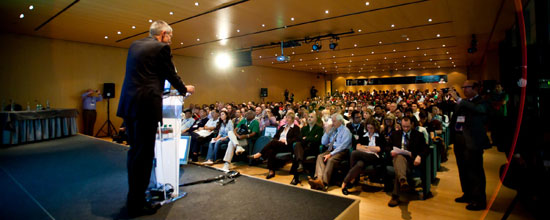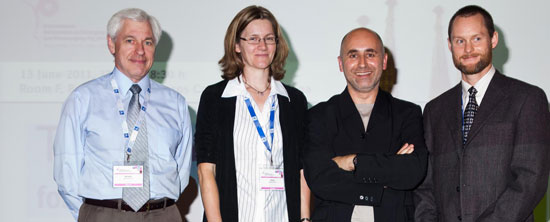 An important anniversary in the history of porcine circovirus type 2 (PCV2) has been marked at a special international pig veterinary satellite symposium held in Barcelona, Spain in June 2011 as part of the 6th International Symposium on Emerging and Re-emerging Pig Diseases. In 2011, this meeting heard, it is 15 years since the name PMWS was first proposed by Canadian investigators Ted Clark and John Harding for the novel wasting disease of growing pigs that they were observing in herds in Western Canada. Prof. John Harding acted as a moderator as well as speaker for the well attended symposium.
An important anniversary in the history of porcine circovirus type 2 (PCV2) has been marked at a special international pig veterinary satellite symposium held in Barcelona, Spain in June 2011 as part of the 6th International Symposium on Emerging and Re-emerging Pig Diseases. In 2011, this meeting heard, it is 15 years since the name PMWS was first proposed by Canadian investigators Ted Clark and John Harding for the novel wasting disease of growing pigs that they were observing in herds in Western Canada. Prof. John Harding acted as a moderator as well as speaker for the well attended symposium.Prof. John C.S. Harding: PCV2 milestones over 15 years.
October 1994 supplied a key landmark when the University of Saskatchewan began to investigate unusual cases of wasting and jaundice in piglets from farms in Western Canada. This was followed in 1997 with the breakthrough by scientists in Northern Ireland and Canada that the virus involved was a novel type of the porcine circovirus.

Fifteen years would be an extremely short time in the development of most pig diseases, so it is all the more remarkable that piglet vaccination against PCV2 has already been developed and has become such a global success story in controlling the economically damaging range of health problems associated with the virus. The first vaccines did not appear until 2004, yet today PCV2 vaccination is routinely used in all leading pig markets with up to 90% of pigs vaccinated against the disease. This has posed questions for the future which have been addressed by the symposium speakers in equally interesting and entertaining presentations:
Prof. Tanja Opriessnig: Impact of PCV2 on breeding herds.
Prof. Michael P. Murtaugh: Is PCV2 eradication possible?
Prof. Joaquim Segales: Beyond PCV2: What´s next?
The PCV2 virus has provided one of the best examples so far of the devastating effects of an emerging virus on the global pig population --- as well as the unprecedented success story of piglet vaccination in achieving effective control of PCVD.
In conclusion of the satellite symposium, Prof Harding added, it will not be the last disease agent to emerge and to assault the pig industry. Most probably, the advance elements of the next attack are already circulating in pigs today. So we need to stay on guard.

Boehringer Ingelheim Animal Health



